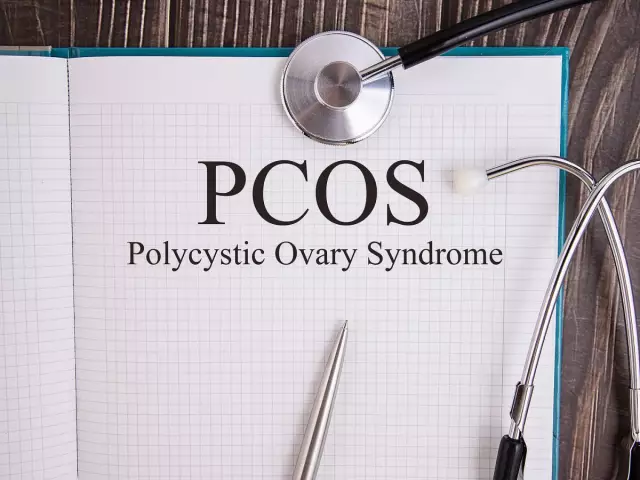- Author Rachel Wainwright [email protected].
- Public 2023-12-15 07:39.
- Last modified 2025-11-02 20:14.
Ovary
The ovary is a paired female reproductive gland in the pelvic cavity, which, in addition to the hormonal one, also performs a reproductive function.

Ovary structure
The ovary is oval in shape, it is up to 3.5 cm long, up to 2.5 cm wide, and up to 1.5 cm thick. According to observations, the right ovary is larger than the left. One end of this gland faces the fallopian tube, the other is attached to the uterus by its own ligament of the ovary. In the wide ligament of the uterus, next to it are the ovarian epididymis and the periovary.
In the structure of a mature ovary, the cortical, medulla and gates are distinguished. In the gate, in addition to the bundle of blood and lymph vessels and the nerve bundle, there is connective tissue and chyle cells that secrete androgens.
The connective tissue medulla is adjacent to the gate. Above the medulla is the cortex, which makes up most of the ovary. It is based on connective tissue and cells that form hormones androgens. At the base are follicles, whitish and yellow bodies.
Ovarian follicles differ in developmental stages. In one menstrual cycle, only one follicle fully develops - the dominant one. Follicles that have not reached the last stage of development die off. In place of the follicle, which underwent ovulation, the so-called corpus luteum is formed. It is called so because the granulosa cells that form it, due to the large accumulation of fat, give this formation a yellow color. In the event that fertilization has not occurred, the corpus luteum is gradually replaced by connective tissue, and a white body is formed in its place. In the place of rupture of the follicle, scars form on the ovarian membrane.
Ovary functions
Eggs are formed in the ovarian follicle, which, if fertilized, give life to a new organism. The corpus luteum formed at the site of the follicle at the onset of pregnancy releases the hormone progesterone, which contributes to its preservation and bearing of the fetus.
In addition, the ovaries produce a number of other hormones - androgens and estrogens. Androgens (testosterone, androstenedione) in the female body act as an intermediate product before the synthesis of estrogens (estradiol, estrone).
Estrogens are responsible for the formation of signs of the female body - external and internal genital organs, skeleton, mammary glands, androgens are responsible for hair growth of the pubis and armpits. The alternation of the activity of progesterone and estrogen affects the state of the epithelium of the mucous membrane of the uterus and vagina, determining the cycle of menstruation.
Ovarian function examination
The study begins with anamnesis - the woman is asked when menstruation began, the characteristics of the menstrual cycle - the amount of discharge, pain, cycle duration, regularity, etc.
On examination, attention is paid to the physique, the nature of hair growth, the development of the mammary glands, external genital organs - they directly depend on the hormonal activity of the ovary.
A blood test for sex hormones also helps to determine the functional activity of the female sex glands.
Ultrasound examination of the ovaries allows you to assess their size and location, as well as assess the development of the follicle in dynamics. This highly informative method has found widespread use and replaced older learning methods. Laparoscopic examination with the use of an endoscope allows not only to visually evaluate these glands, but also to simultaneously carry out some manipulations to treat the ovaries.
Ovarian Diseases and Treatment Approaches
Most often, the pathology of the female genital glands is manifested by the following symptoms:
- Menstrual irregularities;
- Puberty disorders;
- Infertility;
- Uterine bleeding;
- Lower abdominal pain.
A comprehensive gynecological examination will reveal the specific causes and diseases of the ovaries.
Inflammation of the ovaries - manifested by aching, pulling pains in the lower abdomen, periodically radiating to the lower back, sacrum. Unpleasant sensations are also noted during intercourse. These symptoms are worse during menstruation. Sometimes they are accompanied by a rise in body temperature, chills, signs of dysuria. Abundant transparent discharge may leave the genital tract. If the inflammation goes into a chronic phase, then it can cause infertility, menstrual irregularities.
Ovarian inflammation can be caused by bacteria that have entered it from the environment - these are mycoplasmas, chlamydia, gonococcus, Trichomonas. Sometimes it is provoked by those microorganisms that are safe in a healthy body, and show their pathogenic properties with a decrease in local or general immunity. Inflammation of the ovaries easily spreads to the fallopian tubes, causing damage to their inner epithelium with the subsequent formation of adhesions.
If suspicious symptoms appear, you should see a gynecologist. Treatment of the ovaries for inflammation is mainly conservative and includes a course of antibacterial, anti-inflammatory and antifungal drugs. Additionally, sometimes antihistamines, vitamins and general strengthening procedures are prescribed.
Polycystic ovary syndrome may first appear as early as the age of 12-14, when the ovaries are just beginning to reproduce. But more often a detailed picture of the disease can be observed by the age of 30. In a woman with polycystic ovary, the ovaries look bumpy on ultrasound due to the many cysts - bubbles up to 10 mm in diameter with fluid inside. Cysts are follicles from which the egg cannot enter the abdominal cavity - ovulation does not occur, and therefore it becomes impossible to conceive.
Women with polycystic syndrome have a characteristic appearance - excessive body hair - hirsutism, acne, increased pigmentation, which occur due to an excess of male sex hormones. Up to 40% of women with this pathology are obese.
The diagnosis of polycystic ovary disease is established on the basis of ultrasound and analysis of hormones in the blood (testosterone, progesterone) on certain days of the sexual cycle. It is important to conduct all studies under the supervision of a gynecologist.
Treatment of the ovaries in the case of polycystic disease is to lower the level of androgens - male sex hormones, and normalize the menstrual cycle. This is achieved with the use of some therapeutic oral contraceptives. Pregnancy, if it occurs, also has a positive effect on polycystic ovary disease.
Found a mistake in the text? Select it and press Ctrl + Enter.






